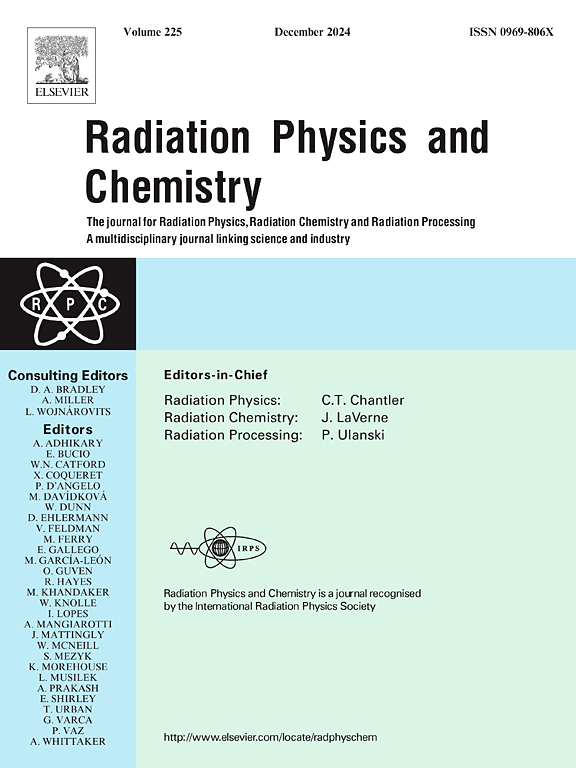Influence of the low-energy backscattering spectrum on the calibration of thin alpha-particle sources
IF 2.8
3区 物理与天体物理
Q3 CHEMISTRY, PHYSICAL
引用次数: 0
Abstract
The activity of thin alpha-particle sources with negligible self-absorption can be absolutely determined using 2π counting geometry systems, correcting for backscattering from the source backing. This procedure requires to perform an extrapolation to zero energy in the experimental counting rate, due to the existence of events produced by recoiling daughters and electronic noise in the low-energy region. In addition, the Monte Carlo simulation has proven that the energy distribution of the backscattered alpha particles is not flat, showing a ‘‘peak” at the low-energy region which is due to multiple scattering in the backing. In this work, we demonstrate that a significant part of the backscattered particles included in this “peak” are not contained in the extrapolated counting rate, which implies an underestimation of the source activity if the total backscattering coefficient is considered. We applied MC simulation with the well-known code SRIM to evaluate this underestimation depending on the energy of alpha emitters and on the backing. Our results show that the underestimation in the activity can be even close to 1 % in the case of backings with high atomic numbers, which can be considered as significative in metrological measurements for the standardization of alpha-particle sources. In addition, a new procedure is proposed here to correct for this effect, which includes only the simulation of alpha particles in the source backing, without attending to the source substrate. This new procedure is finally applied to some sources from the literature, where the backscattering coefficients were obtained experimentally, providing satisfactory results.
低能后向散射光谱对细粒子源标定的影响
具有可忽略自吸收的薄α粒子源的活度可以用2π计数几何系统绝对确定,校正了源背向散射。由于在低能区存在由反冲子体和电子噪声产生的事件,该过程需要在实验计数率中执行零能量外推。此外,Monte Carlo模拟还证明了后向散射α粒子的能量分布不是平坦的,在低能区出现了一个“峰值”,这是由于背向的多次散射。在这项工作中,我们证明了包含在该“峰”中的大量后向散射粒子不包含在外推计数率中,这意味着如果考虑总后向散射系数,则低估了源活度。我们应用MC模拟与著名的代码SRIM来评估这种低估取决于α发射器的能量和背景。我们的结果表明,在具有高原子序数的背景下,活度的低估甚至可以接近1%,这在α粒子源标准化的计量测量中可以被认为是有意义的。此外,本文提出了一种新的程序来纠正这种影响,该程序只包括源背中的α粒子的模拟,而不涉及源底。最后将该方法应用于一些文献资料源的后向散射系数实验,得到了满意的结果。
本文章由计算机程序翻译,如有差异,请以英文原文为准。
求助全文
约1分钟内获得全文
求助全文
来源期刊

Radiation Physics and Chemistry
化学-核科学技术
CiteScore
5.60
自引率
17.20%
发文量
574
审稿时长
12 weeks
期刊介绍:
Radiation Physics and Chemistry is a multidisciplinary journal that provides a medium for publication of substantial and original papers, reviews, and short communications which focus on research and developments involving ionizing radiation in radiation physics, radiation chemistry and radiation processing.
The journal aims to publish papers with significance to an international audience, containing substantial novelty and scientific impact. The Editors reserve the rights to reject, with or without external review, papers that do not meet these criteria. This could include papers that are very similar to previous publications, only with changed target substrates, employed materials, analyzed sites and experimental methods, report results without presenting new insights and/or hypothesis testing, or do not focus on the radiation effects.
 求助内容:
求助内容: 应助结果提醒方式:
应助结果提醒方式:


